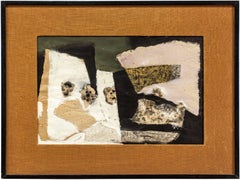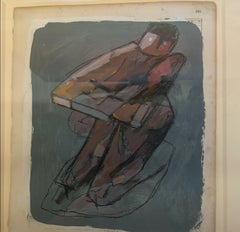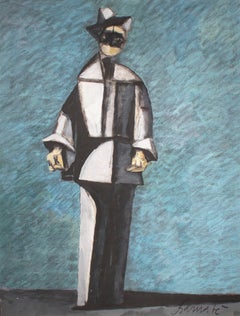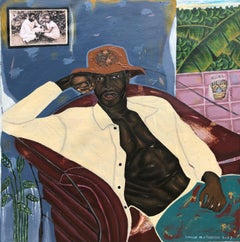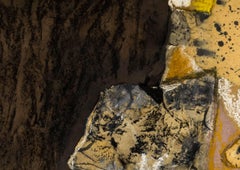George Nama Mixed Media
to
2
4
2
2
2
1
1
Overall Height
to
Overall Width
to
2
2
2
2
1
16
470
270
213
206
3
2
2
2
2
Artist: George Nama
Fragment Replaced
By George Nama
Located in Surfside, FL
In his studio, Nama paints over the right hand pages with gesso, then uses the pages to draw and paint sketches of forms and shapes as they float through his mind. The process is sym...
Category
Mid-20th Century Modern George Nama Mixed Media
Materials
Paper, Mixed Media
Fragment Replaced, Torn Paper Collage, Paint 1960s Avant Garde Mixed Media
By George Nama
Located in Surfside, FL
Genre: Avant-Garde
Subject: Abstract
Medium: Mixed Media, Collage
Surface: Paper
Country: United States
Dimensions: 14" x 19"
Dimensions w/Frame: 19.25" x 25.5"
In his studio, Nama p...
Category
1960s Modern George Nama Mixed Media
Materials
Paint, Paper, Ink, Mixed Media
Untitled
By George Nama
Located in Santa Monica, CA
Gouache and charcoal on antique music paper
Category
2010s Contemporary George Nama Mixed Media
Materials
Charcoal, Gouache
Untitled
By George Nama
Located in Santa Monica, CA
Gouache and charcoal on antique music paper
Category
21st Century and Contemporary Contemporary George Nama Mixed Media
Materials
Charcoal, Gouache
Related Items
Arlecchino in blu e grigio (Harlequin in Blue and Gray)
By Duilio Barnabe
Located in Chicago, IL
This work is signed by Barnabè in the lower right. Harlequins were one of Barnabè's favorite subjects, reminders of the costumed revellers at the famous Carnival of Venice celebrated...
Category
Mid-20th Century Modern George Nama Mixed Media
Materials
Charcoal, Gouache
Moment of Reflections 1
Located in Ibadan, Oyo
In "Moment of Reflections," Olatunbosun transports the audience into a world of contemplation and self-discovery. The centerpiece of the artwork is a young man seated in a casual, relaxed manner. His pose conveys a sense of tranquility as if he has found solace in the moments of quiet contemplation. The attention to detail in the artwork is striking, with intricate brushwork bringing out the textures of the subject's clothing and the surrounding environment.
The setting of the artwork is deliberately minimalistic, allowing the viewer to focus entirely on the young man's expression and demeanor. The background is a subtle blend of soft colors, suggesting an ethereal space where thoughts roam freely. This simplicity further accentuates the theme of reflection, as the absence of distractions allows viewers to immerse themselves in their own thoughts while contemplating the emotions conveyed by the subject.
Olatunbosun's "Moment of Reflections" is a remarkable piece that resonates deeply with viewers from all walks of life. The young man's expression exudes a sense of inner peace, prompting viewers to ponder their own life experiences and contemplate the paths they have taken. This introspective quality of the artwork creates an intimate connection between the audience and the subject, allowing for a deeply personal and emotional experience.
The painting's title, "Moment of Reflections," is deliberately chosen to reinforce the idea of taking a moment for self-exploration and soul-searching. In the hustle and bustle of modern life, we often overlook the importance of pausing and reflecting on our journey. Olatunbosun's artwork serves as a gentle reminder to find time for introspection and to appreciate the beauty in moments of quietude.
What makes "Moment of Reflections" even more extraordinary is its ability to transcend cultural boundaries. The emotions depicted in the artwork are universal, touching the core of human experiences. Whether the viewer is from the artist's homeland or halfway across the world, the profound message remains relevant – we all share moments of contemplation and self-discovery in our lives.
In conclusion, Samson Olatunbosun's "Moment of Reflections" is a timeless masterpiece that captures the human spirit with its simplicity and emotional depth. Through his brilliant artistic skill, Olatunbosun creates an atmosphere of introspection, inviting viewers to engage in their own moments of contemplation and self-discovery. This extraordinary artwork serves as a poignant reminder of the power of art to connect us all through our shared humanity and emotions. As we gaze upon the young man seated in a relaxed manner, we are reminded to embrace the beauty of silence, to reflect on our past, and to seek meaning in the present – a truly profound and impactful journey offered by the artistic genius of Samson Olatunbosun.
Shipping Procedure
Ships in a well-protected tube from Nigeria
This work is unique, not a print or other type of copy.
Accompanied by a Certificate of Authenticity (Issued by the Gallery)
About Artist
Samson Olatubosun...
Category
19th Century Modern George Nama Mixed Media
Materials
Mixed Media, Photographic Paper, Acrylic, Oil, Canvas
Original-Golden Summer-Sunlit, UK Awarded Artist, Garden, Rose, Heather, Lilies
Located in London, GB
Shizico spent three days painting this plein air in her sunlit garden. She applied 550 Ture Gold paint and Van Gogh Yellow creating a stunning backdrop which served as the canvas for...
Category
2010s Abstract Expressionist George Nama Mixed Media
Materials
Gold
H 16.54 in W 11.82 in D 0.04 in
Original-Dahlias, Monsteras & Six Birds-UK Awarded Artist, Abstract-Expression-
Located in London, GB
In this Series, Shizico delves deep into the intricacies of form and contrasts the bold interplay of yellow and black. She then introduces a third element, adding layers of complexit...
Category
2010s Abstract Expressionist George Nama Mixed Media
Materials
Gold Leaf
H 19.49 in W 15.56 in D 0.56 in
Nude Woman on Striped Chair #2 in Charcoal and Gouache on Paper
Located in Soquel, CA
Nude Woman on Striped Chair #2 in Charcoal and Gouache on Paper
Black and white painting of a woman by acclaimed bluegrass musician Katherine "Kathy" Kallick (American, b. 1952). Th...
Category
1970s Contemporary George Nama Mixed Media
Materials
Charcoal, Gouache, Paper
H 19 in W 14 in D 0.02 in
Rare Modernist Hungarian Rabbi Pastel Drawing Gouache Painting Judaica Art Deco
By Hugó Scheiber
Located in Surfside, FL
Rabbi in the synagogue at prayer wearing tallit and tefillin.
Hugó Scheiber (born 29 September 1873 in Budapest – died there 7 March 1950) was a Hungarian modernist painter.
Hugo Scheiber was brought from Budapest to Vienna at the age of eight where his father worked as a sign painter for the Prater Theater. At fifteen, he returned with his family to Budapest and began working during the day to help support them and attending painting classes at the School of Design in the evening, where Henrik Papp was one of his teachers. He completed his studies in 1900. His work was at first in a post-Impressionistic style but from 1910 onward showed his increasing interest in German Expressionism and Futurism. This made it of little interest to the conservative Hungarian art establishment.
However, in 1915 he met the great Italian avant-gardist Filippo Tommaso Marinetti and the two painters became close friends. Marinetti invited him to join the Futurist Movement. The uniquely modernist style that he developed was, however, closer to German Expressionism than to Futurism and eventually drifted toward an international art deco manner similar to Erté's. In 1919, he and his friend Béla Kádar held an exhibition at the Hevesy Salon in Vienna. It was a great success and at last caused the Budapest Art Museum to acquire some of Scheiber's drawings. Encouraged, Scheiber came back to live in Vienna in 1920.
A turning point in Scheiber's career came a year later, when Herwarth Walden, founder of Germany's leading avant-garde periodical, Der Sturm, and of the Sturm Gallery in Berlin, became interested in Scheiber's work. Scheiber moved to Berlin in 1922, and his paintings soon appeared regularly in Walden's magazine and elsewhere. Exhibitions of his work followed in London, Rome, La Paz, and New York.
Scheiber's move to Germany coincided with a significant exodus of Hungarian artists to Berlin, including Laszlo Moholy-Nagy and Sandor Bortnyik. There had been a major split in ideology among the Hungarian avant-garde. The Constructivist and leader of the Hungarian avantgarde, Lajos Kassák (painted by Hugó Scheiber in 1930) believed that art should relate to all the needs of contemporary humankind. Thus he refused to compromise the purity of his style to reflect the demands of either the ruling class or socialists and communists. The other camp believed that an artist should be a figurehead for social and political change.
The fall out and factions that resulted from this politicisation resulted in most of the Hungarian avant gardists leaving Vienna for Berlin. Hungarian émigrés made up one of the largest minority groups in the German capital and the influx of their painters had a significant effect on Hungarian and international art. Another turning point of Scheiber's career came in 1926, with the New York exhibition of the Société Anonyme, organized by Katherine Dreier. Scheiber and other important avant garde artists from more than twenty-three countries were represented. In 1933, Scheiber was invited by Marinetti to participate in the great meeting of the Futurists held in Rome in late April 1933, Mostra Nazionale d’Arte Futurista where he was received with great enthusiasm. Gradually, the Hungarian artists began to return home, particularly with the rise of Nazism in Germany. Kádar went back from Berlin in about 1932 and Scheiber followed in 1934.
He was then at the peak of his powers and had a special flair in depicting café and cabaret life in vivid colors, sturdily abstracted forms and spontaneous brush strokes. Scheiber depicted cosmopolitan modern life using stylized shapes and expressive colors. His preferred subjects were cabaret and street scenes, jazz musicians, flappers, and a series of self-portraits (usually with a cigar). his principal media being gouache and oil. He was a member of the prestigious New Society of Artists (KUT—Képzőművészek Új Társasága)and seems to have weathered Hungary's post–World War II transition to state-communism without difficulty. He continued to be well regarded, eventually even receiving the posthumous honor of having one of his images used for a Russian Soviet postage stamp (see image above). Hugó Scheiber died in Budapest in 1950.
Paintings by Hugó Scheiber form part of permanent museum collections in Budapest (Hungarian National Museum), Pecs (Jannus Pannonius Museum), Vienna, New York, Bern and elsewhere. His work has also been shown in many important exhibitions, including:
"The Nell Walden Collection," Kunsthaus Zürich (1945)
"Collection of the Société Anonyme," Yale University Art Gallery, New Haven, Connecticut (1950)
"Hugó Scheiber: A Commemorative Exhibition," Hungarian National Museum, Budapest (1964)
"Ungarische Avantgarde," Galleria del Levante, Munich (1971)
"Paris-Berlin 1900-1930," Centre Georges Pompidou, Paris (1978)
"L’Art en Hongrie, 1905-1920," Musée d’Art et l’Industrie, Saint-Etienne (1980)
"Ungarische Avantgarde in der Weimarer Republik," Marburg (1986)
"Modernizmus," Eresz & Maklary Gallery, Budapest (2006)
"Hugó Scheiber & Béla Kádár," Galerie le Minotaure, Paris and Tel Aviv (2007)
Hugó Scheiber's paintings continue to be regularly sold at Sotheby's, Christie's, Gillen's Arts (London), Papillon Gallery (Los Angeles) and other auction houses.
He was included in the exhibition The Art Of Modern Hungary 1931 and other exhibitions along with Vilmos Novak Aba, Count Julius Batthyany, Pal Bor, Bela Buky, Denes Csanky, Istvan Csok, Bela Czobel, Peter Di Gabor, Bela Ivanyi Grunwald, Baron Ferenc Hatvany, Lipot Herman, Odon Marffy, C. Pal Molnar...
Category
Early 20th Century Modern George Nama Mixed Media
Materials
Paper, Charcoal, Pastel, Watercolor, Gouache
"Leaning in Chair" Mid-Century Figurative
By Gloria Dudfield
Located in Arp, TX
Gloria Dudfield
Leaning in Chair
1960's
Gouache and Charcoal on Paper
11.75"x17.75" unframed.
Gloria (Fischer) Dudfield
July 12, 1922 – May 27, 2015
Came from a portfolio of her wor...
Category
Mid-20th Century Abstract George Nama Mixed Media
Materials
Paper, Charcoal, Gouache
Nude Woman on Striped Chair #1 in Charcoal and Gouache on Paper
Located in Soquel, CA
Nude Woman on Striped Chair #1 in Charcoal and Gouache on Paper
Black and white painting of a woman by acclaimed bluegrass musician Katherine "Kathy" Kallick (American, b. 1952). Th...
Category
1970s Contemporary George Nama Mixed Media
Materials
Charcoal, Gouache, Paper
H 14.25 in W 18.25 in D 0.02 in
Sunny Side Of Life
By Martina Niederhauser
Located in Los Angeles, CA
Internationally acclaimed artist Martina Niederhauser presents a new collection that offers fresh perspectives on women, delving into the realms of emotion, beauty, identity, and the...
Category
21st Century and Contemporary Contemporary George Nama Mixed Media
Materials
Canvas, Mixed Media, Oil, Acrylic, Gouache, Archival Paper
Garden Of Your Mind
By Martina Niederhauser
Located in Los Angeles, CA
Internationally acclaimed artist Martina Niederhauser presents a new collection that offers fresh perspectives on women, delving into the realms of emotion, beauty, identity, and the...
Category
21st Century and Contemporary Contemporary George Nama Mixed Media
Materials
Canvas, Mixed Media, Oil, Acrylic, Gouache, Archival Paper
"Repetition" Chryssa, Greek Female Artist, Abstract, Neon Light Art Study
By Chryssa Vardea-Mavromichali
Located in New York, NY
Chryssa
Repetition
Signed lower right; titled on the reverse
Gouache, watercolor, charcoal, and graphite on paper
15 x 11 inches
Born and educated in Athens, Greece, Vardea Chryssa, known professionally as Chryssa, became a U.S. citizen and earned a reputation for her sculptured assemblages utilizing light from neon, and plexiglas combined with mixed media pieces. One of her pieces, Untitled Light Sculpture (1980) is 22 feet long and is installed in the atrium of a building at 33 Monroe Street in Chicago. It was programmed electronically to create changing patterns of reflected light through 900 feet of neon tubing.
Chryssa's sculptures with precision and definite form were a reaction against the prevalent Abstract Expressionism of the 1950s with its emphasis purely upon the artist's intent. In her work, the focus is on materials and the way they are shaped for specific use by craftsmen.
She got her early education in Athens, and first studied to be a social worker. She was then sent by the Greek Ministry of Social Welfare to the Dodecanese Islands and later to the Ionian Sea island of Zante, whose population had suffered great loss from earthquakes. Disillusioned that monies were being provided to restore monasteries but not to help other earthquake victims, Chryssa changed her life's direction to become a painter. In Athens, she studied art with Anghelos Prokopion.
Then she went to Paris, France, and studied briefly at the Academie Grande Chaumiere and associated with surrealists Andre Breton, Edgard Varese, and Max Ernst. In 1954, she moved to San Francisco, California for a year of study at the California School of Fine Arts, and there she first saw the work of Jackson Pollock, which had a freeing affect on her and inspired her to experiment with pure form. But later she reacted against action painting with her assemblage sculptures of controlled precision.
In 1955, Chryssa settled in New York City, and became the first artist to incorporate neon light tubing and commercial signs into sculpture. It is asserted that her "mature work grew out of the Greek experience, before and after World War II, wedded to the raucous letters, signs, symbols, and lights of Time Square, New York City" (Heller 125). In fact, she was so taken with the lights of Times Square that she unsuccessfully tried to get a job as a sign maker but was prevented by labor union rules. However, one of the members gave her sign-making lessons in his shop.
She first made Pop images such as depictions of automobile tires and cigarettes and in sculptures, utilized letters of the alphabet, ideas that predated similar images by Jasper Johns and Andy Warhol. Her first major work of interwoven light and letters was Times Square Sky of 1962, but she was dissatisfied because she thought the piece was too crowded. To create a sense of breathing, she inserted neon light, and for the first time, this material became an art medium.
From that time, she was prolific and created many variations based on the letters W and A. For her, a primary motivating factor was remaining cool or mentally collected amidst the onslaught of bombarding information and to process it through her creations in new ways so that nothing was repeated. She set up her own work place...
Category
Late 20th Century Abstract George Nama Mixed Media
Materials
Gouache, Graphite, Paper, Charcoal, Watercolor
Moment of Reflections 2
Located in Ibadan, Oyo
In "Moment of Reflections," Olatunbosun transports the audience into a world of contemplation and self-discovery. The centerpiece of the artwork is a young man seated in a casual, relaxed manner. His pose conveys a sense of tranquility as if he has found solace in the moments of quiet contemplation. The attention to detail in the artwork is striking, with intricate brushwork bringing out the textures of the subject's clothing and the surrounding environment.
The setting of the artwork is deliberately minimalistic, allowing the viewer to focus entirely on the young man's expression and demeanor. The background is a subtle blend of soft colors, suggesting an ethereal space where thoughts roam freely. This simplicity further accentuates the theme of reflection, as the absence of distractions allows viewers to immerse themselves in their own thoughts while contemplating the emotions conveyed by the subject.
Olatunbosun's "Moment of Reflections" is a remarkable piece that resonates deeply with viewers from all walks of life. The young man's expression exudes a sense of inner peace, prompting viewers to ponder their own life experiences and contemplate the paths they have taken. This introspective quality of the artwork creates an intimate connection between the audience and the subject, allowing for a deeply personal and emotional experience.
The painting's title, "Moment of Reflections," is deliberately chosen to reinforce the idea of taking a moment for self-exploration and soul-searching. In the hustle and bustle of modern life, we often overlook the importance of pausing and reflecting on our journey. Olatunbosun's artwork serves as a gentle reminder to find time for introspection and to appreciate the beauty in moments of quietude.
What makes "Moment of Reflections" even more extraordinary is its ability to transcend cultural boundaries. The emotions depicted in the artwork are universal, touching the core of human experiences. Whether the viewer is from the artist's homeland or halfway across the world, the profound message remains relevant – we all share moments of contemplation and self-discovery in our lives.
In conclusion, Samson Olatunbosun's "Moment of Reflections" is a timeless masterpiece that captures the human spirit with its simplicity and emotional depth. Through his brilliant artistic skill, Olatunbosun creates an atmosphere of introspection, inviting viewers to engage in their own moments of contemplation and self-discovery. This extraordinary artwork serves as a poignant reminder of the power of art to connect us all through our shared humanity and emotions. As we gaze upon the young man seated in a relaxed manner, we are reminded to embrace the beauty of silence, to reflect on our past, and to seek meaning in the present – a truly profound and impactful journey offered by the artistic genius of Samson Olatunbosun.
Shipping Procedure
Ships in a well-protected tube from Nigeria
This work is unique, not a print or other type of copy.
Accompanied by a Certificate of Authenticity (Issued by the Gallery)
About Artist
Samson Olatubosun...
Category
19th Century Modern George Nama Mixed Media
Materials
Canvas, Mixed Media, Oil, Acrylic, Photographic Paper
Previously Available Items
Fragment Replaced, Torn Paper Collage, Paint 1960s Avant Garde Mixed Media
By George Nama
Located in Surfside, FL
Genre: Avant-Garde
Subject: Abstract
Medium: Mixed Media, Collage
Surface: Paper
Country: United States
Dimensions: 14" x 19"
Dimensions w/Frame: 19.25" x 25.5"
In his studio, Nama p...
Category
1960s Modern George Nama Mixed Media
Materials
Paint, Paper, Ink, Mixed Media
Fragment Replaced
By George Nama
Located in Surfside, FL
In his studio, Nama paints over the right hand pages with gesso, then uses the pages to draw and paint sketches of forms and shapes as they float through his mind. The process is sym...
Category
Mid-20th Century Modern George Nama Mixed Media
Materials
Paper, Mixed Media
George Nama mixed media for sale on 1stDibs.
Find a wide variety of authentic George Nama mixed media available for sale on 1stDibs. You can also browse by medium to find art by George Nama in paint, charcoal, gouache and more. Much of the original work by this artist or collective was created during the 21st century and contemporary and is mostly associated with the modern style. Not every interior allows for large George Nama mixed media, so small editions measuring 10 inches across are available. Customers who are interested in this artist might also find the work of Margaret Putnam, Tom Binger, and Stephen Longstreet. George Nama mixed media prices can differ depending upon medium, time period and other attributes. On 1stDibs, the price for these items starts at $900 and tops out at $2,200, while the average work can sell for $1,550.
